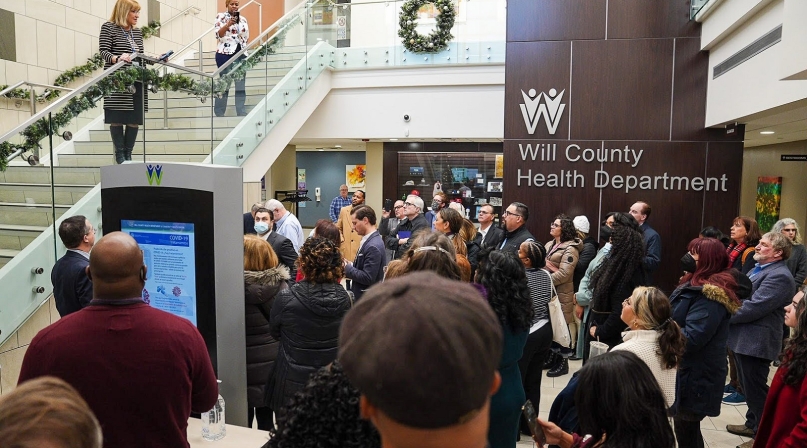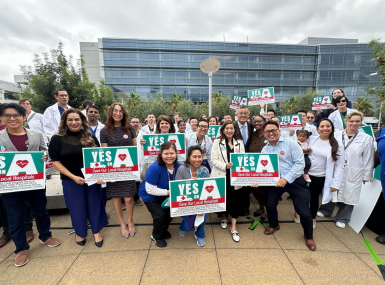LUCC members tour transportation, health centers

Key Takeaways
NACo’s Large Urban County Caucus (LUCC) members attended mobile tours of the United Bridge Partners’ Houbolt Road Extension project, the BNSF Railway Intermodal facility and Lion Electric Manufacturing Nov. 30 and Will County, Illinois’s health department and health center on Dec. 2.
Will County, Ill. is the largest inland port in the country. As a transportation hub, the county subsequently has to deal with things like clogged roadways and greenhouse gas emissions. The Nov. 30 mobile tour showed LUCC members the county’s innovative projects that are in the works to increase convenience, efficiency and sustainability in transportation.
Houbolt Road is undergoing a 1.5-mile extension from U.S. 6 to Schweitzer Road with a new bridge over the Des Plaines River, which will reduce truck traffic on local roads and is providing construction jobs. LUCC members were given a rundown on the project’s logistics and stopped to check out the construction.
“We have all these containers and trucks, everything moving around, but in order to get to the highway, everybody has to go on these little side streets that were not designed to support that level of traffic, so our company is working together with CenterPoint properties and we’re building this quarter mile bridge,” a UBP representative told LUCC members. “We’re making it more efficient to move goods in and out of this area, because the train yard could be as efficient all day long, but if you can’t get those goods out onto the roads –– time is money, emissions are making an impact, so everything that we’re doing is just making it much easier, faster, more efficient to move these things out to the highway.”
Jennifer Rutledge, Rockdale County, Ga.’s executive director of government affairs, said she would take information from the road extension project back to apply to her county, which is in the planning stages of a bridge project of its own.
“In Rockdale County, we are in the middle of building an overpass bridge over Interstate 20, which actually cuts our county in half, and it was very interesting to watch their bridge project as it’s being constructed, because we are doing the same exact thing,” she noted.
“They’re a little further along than we are, but what I really appreciated was listening to the public-private partnership and the way that they’re collecting the toll fees to kind of recoup some of that money, so I’m going to take that back and look into it, especially with our federal delegation and see if they can help us out with the same type of partnership or maybe some other ways to fund such an expensive piece of infrastructure.”
Amid discussions around a national rail strike, LUCC members drove around the BNSF Railways Intermodal facility. Last year, 5.4 million intermodal shipments were transported on BNSF’s rail lines instead of highways, reducing traffic and increasing efficiency. BNSF moves about 2.5 million new cars and trucks per year and transports enough grain to supply 900 million people with a year’s supply of bread.
“Not only are we the biggest inland port for international [trade] here in North America, we also have the third or fourth most-busy auto facility,” a BNSF representative said. “We like to call it ‘window shopping’ around here, but you can see about 9,000 bins and cars being loaded and unloaded on our facility –– we’ve got four tracks.”
BNSF is currently working on expanding its technology with remote control, so that items can be moved from a joystick within an office to increase worker safety and speed up the process, he said.
LUCC members also heard about Lion Electric’s sustainability solutions for transportation at its nearly 1 million-square foot manufacturing facility, featuring models of its all-electric urban trucks and shuttle/transit minibus, and got the opportunity to ride in one of its electric school buses.
McPherson County, Kan. Commissioner Keith Becker said that he was particularly impressed with the Lion Electric factory.
“They’re gearing up for the future is what they’re doing,” he said.
LUCC members tour Will County’s health department
NACo President Denise Winfrey, a member of the Will County, Ill. board, gave the opening remarks in a presentation Dec. 2 on the county’s healthcare programming. She highlighted the community’s involvement in the county’s new health department, which opened in 2020 and serves nearly 700,000 people from an 865-square mile area.
“Before we ever turned a shovel here, we had members of the community in to talk about what we’re going to do, let them see the overall game plan, what the impact was going to be for the neighborhood –– we did not displace anybody to be here,” Winfrey said. “This had always been the campus –– where we are now was the parking lot and the old building was where the parking lot is now over here, but we made sure they understood what the impact was going to be at every stage along the development and the growth of this place.”
Stacy Baumgartner, director of operations for the Will County Health Department and Community Health Center, said that the department’s central focuses are affordability and accessibility. A breakdown of the center’s patients showed that 50 percent are Medicaid-eligible, while 34 percent are uninsured.
“Our mission is to improve the health of the residents of Will County by providing access to quality, integrated medical, behavioral health and dental care through community collaboration, service and education,” she said. “I think community collaboration is one of our biggest strengths here. Our purpose is to fulfill the healthcare needs of individuals throughout our county, and as a federally qualified health center, our services aren’t limited to county residents. We’re able to see anybody who walks through our doors.”
Baumgartner is chair of Will County’s Mobilizing for Action Through Planning and Partnerships (MAPP) Executive Committee. In its most recent cycle, the committee assessed the county’s health needs and determined four priority areas:
• behavioral health and substance use
• access to food and nutrition
• stabilizing the built environment
• access to healthcare.
“We do a series of assessments, both internally and externally in the community, and we determine what the needs are of our community,” said Sue Olenek, WCHD executive director. “We have over 80 partners in the county that participate in MAPP –– we use data, we do surveys. This past cycle, we had surveys electronically, we did the QR codes, we also did paper because not everybody has a smartphone. We published it far and wide, and so we want to make sure that we reach everyone.”
Joseph Troiani, the director of behavioral health programs at the county’s health department, discussed the department’s mental health and substance use treatment programming, including its Narcan distribution program, the projects for assistance in transition from homelessness (PATH) program and pre-exposure prophylaxis program for those at risk of HIV. The department’s crisis intervention team training hopes to have as many as 600 officers train as mental health specialists through American Rescue Plan funding, $30 million of which the county devoted to healthcare.
“Over the last 10 years, we’ve seen the suicide rate in the United States go from 32,000 now up to about 72,000,” he said. “We’ve also seen a significant increase in drug overdoses ––doubling if not tripling … The Wall Street Journal talked about a category five mental health crisis as a result of COVID and some of the things that were going on pre-COVID, and these programs that we have in place and the expansion of these programs are definitely there to go ahead and meet that need.”
Attachments
Related News

CMS issues new guidance on Medicaid Community Engagement Requirements
On December 8, the Centers for Medicare & Medicaid Services (CMS) released a Medicaid and CHIP Services Informational Bulletin (CIB) directing states on how to implement the Medicaid community engagement requirements enacted under Section 71119 of the One Big Beautiful Bill Act legislation (Public Law 119-21), or H.R. 1.

U.S. House of Representatives passes SPEED Act and other permitting reform bills
On December 18, the U.S. House of Representatives passed the SPEED Act (H.R. 4776). The SPEED Act would strengthen county involvement in decision-making and make needed commonsense reforms to the federal environmental review process.

California county sales tax measure backfills federal healthcare cuts
Santa Clara County, Calif. will raise an estimated $330 million each year from a sales tax to backfill lose Medicaid funding.
